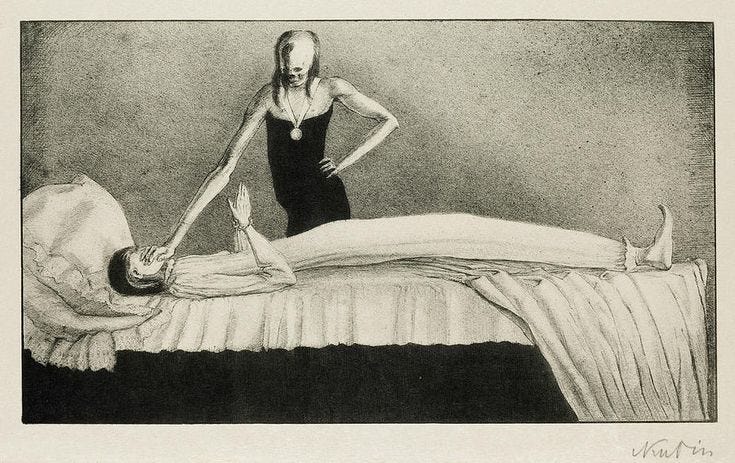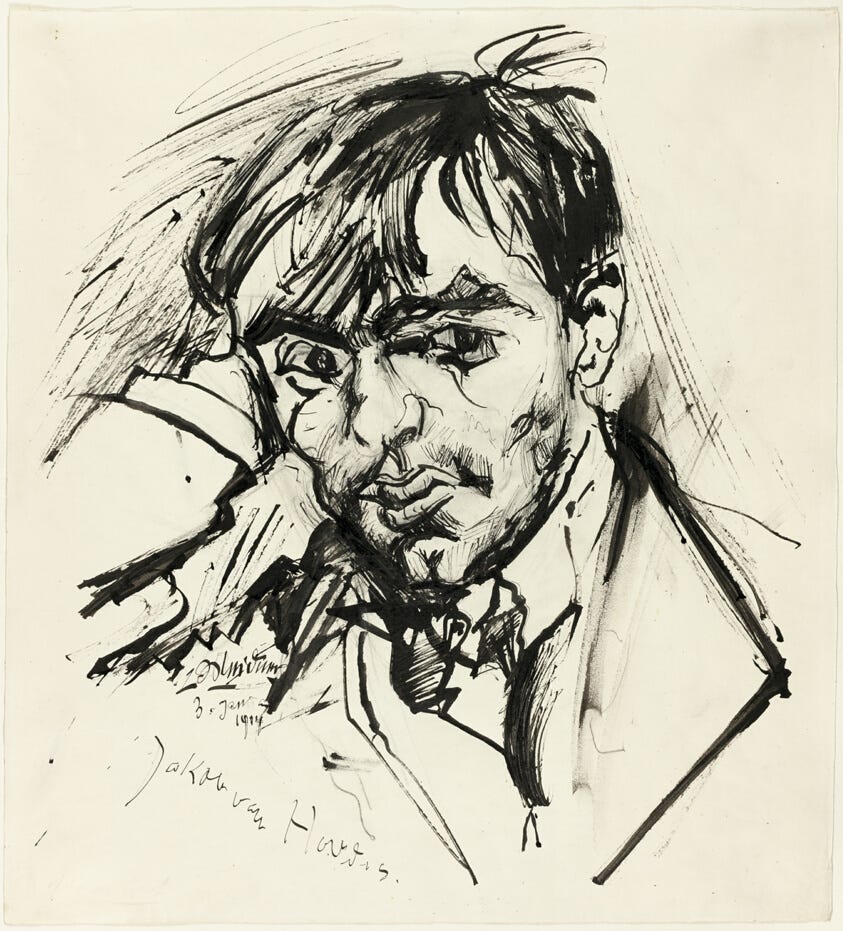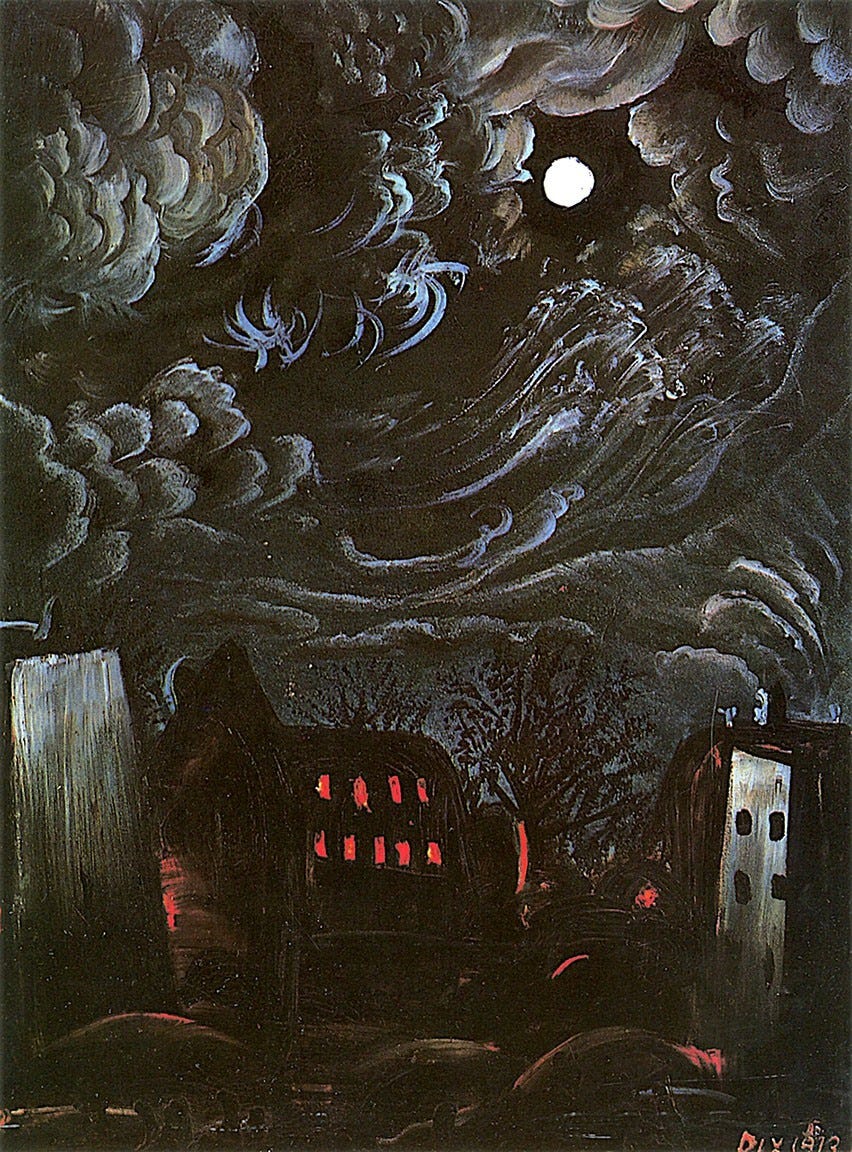Recap of our inaugural post + other news
Twilight of Humanity #2: Purpose and Goal of This Substack
I. THE (LITERARY) OBJECTIVE OF THIS SUBSTACK
As I wrote Tuesday night, this Substack is part of a mission-driven project. The objective of the project is this: Produced here will be a full English translation of the seminal 1919 German Expressionist poetry anthology Menschheitsdämmerung (“Twilight of Humanity”). We will do this poem by poem, page by page, post by Substack post.
That is, we will construct, piece by piece, from the ground up, a publishable English-language version of a critically important anthology of Expressionist literature—Twilight of Humanity—that currently enjoys no English version in print.

There are two ways Subscribers and Followers can enjoy this Substack:
1. As Subscribers and Followers, you may participate in this project through feedback, comments, and deliberative discussion. (Issues that may arise from this, including those regarding fair and commensurate credit, attribution and acknowledgment in the final work, etc., will be discussed in-depth in a separate post.)
—or—
2. As Subscribers and Followers, you may enjoy this Substack the way we intend most of you to enjoy it: as readers. You, dear reader, will be taken on a grand, curated tour of one of the 20th century’s single most fascinating—and singularly dark—European literary documents: THE TWILIGHT OF HUMANITY.

II. WHY THE TITLE “TWILIGHT OF HUMANITY”?
We’re calling both the completed work and this Substack Twilight of Humanity.
This translation from the original German title of “Menschheitsdämmerung” best captures the book’s character, tone, and essence. “Twilight of Humanity” resonates with the sort of Nietzschean language and ideas that preoccupied many of the anthology’s poets. The title also strikes an apocalyptic chord that reflects the apocalyptic themes found throughout the book's poems. Indeed, the very first poem in Twilight of Humanity is Jakob van Hoddis’ apocalyptic, 8-line “End of the World” (“Weltende”). This short poem from van Hoddis, presumably written in 1910, is often considered the first true Expressionist poem.
(In a separate post, we will get a bit into the weeds about the book’s original title, the German compound noun Menschheitsdämmerung, its other possible translations, and why we settled on “Twilight of Humanity.”)
III. HOW THIS BOOK WILL BE BUILT THROUGH SUBSTACK
Here’s how:
We will make at least one post per week. Our ideal is 3 to 4 posts per week.
Each post will feature an original English translation of one of the 278 poems in Menschheitsdämmerung (“Twilight of Humanity”). The original German poem will be at the bottom of the post for reference.
We will proceed through the poems in the order they appear in the first, 1919 edition of Menschheitsdämmerung.
A post featuring a poem from Menschheitsdämmerung may also contain commentary, exegesis, trivia, and other insights into the poem and its author.
Some posts will focus on topics adjacent—but nonetheless relevant—to the book, its authors, and the Expressionist movement. For example, individual posts might flesh out the book’s historical and cultural context (viz., WWI, the Weimar Republic, fascism, the birth of horror cinema, etc.). Literary antecedents and literary offspring, theories of versification and prosody, and biographies of the poets of Twilight of Humanity may also warrant individual posts.
Editor Kurt Pinthus' Foreword to Twilight of Humanity will also receive a dedicated series of posts—it’s too long to feature in one post. Pinthus’ Foreword is a manifesto of Expressionist poetics in its own right and is integral to the volume’s raison d'être.
After all 278 poems plus Kurt Pinthus’ Foreword have been translated into English and posted here, these materials will be gathered up and compiled into a single manuscript. This manuscript will be published in book form as Twilight of Humanity 1919.
We haven’t decided how paid vs. unpaid subscriptions here will work, whether there will be different membership levels (and if so, what privileges will redound to which membership level), etc. We expect to flesh this all out in the coming days as we get the hang of this.
“Night Over the City” (“Nacht in der Stadt”) by German Expressionist Otto Dix, 1913.
IV. LAST BUT NOT LEAST
Right now, Twilight of Humanity 1919 has a target publication date of mid-2025.
When Twilight of Humanity is published, it will be the only English edition in-print of one of the most important, and darkest, works of 20th-century literature. It is of special interest to those who possess an interest in avant-garde poetry, the poetry of horror and the macabre, German cultural history (especially from World War I, through the Weimar era, and into the rise of Nazism), and the darker side of literature generally.
As stated in Tuesday night’s inaugural post, Twilight of Humanity contains 278 poems by 23 different poets across nearly 290 pages. It includes most of the important writers of the German Expressionist movement, including Gottfried Benn, Else Lasker-Schüler, Georg Heym, Georg Trakl, Jakob van Hoddis, Ernst Stadler, Theodor Daubler, Alfred Lichtenstein, August Stramm, and others.
In 1933, Menschheitsdämmerung/Twilight of Humanity was banned by the Nazis under their regulations that attempted to eradicate what they dubbed degenerate (“entarte”) art. That ban was not lifted until World War II ended. Twilight of Humanity is included in the “Library of Burned Books” memorial in Germany.
V. WHAT CRITICS HAVE SAID ABOUT THE ORIGINAL VOLUME:
"The original publication of TWILIGHT OF HUMANITY (November 1919) was a literary-historical event of singular stature, defining in one compendious volume of lyric poetry the breadth and, arguably, also the shared essence of German Expressionism, through its most significant and representative literary genre... The collection, as a whole, is both a high point of Expressionism and its point of no return, both ecstatic and elegiac—a paradox that rightly reflects the dusk and dawn ambiguity of its apocalyptic title; just as rightly, the volume has continued to exert a powerful effect."
—Neil H. Donahue, The German Quarterly, Vol. 68, No. 4 (Autumn, 1995), pp. 471-472
"The success of TWILIGHT OF HUMANITY has endured well beyond the initial sales and rave reviews given it by most contemporaries [in the early 1920s] and has continued over the years playing an important role in the general reception of Expressionism. It has become, in fact, the single most celebrated and often cited document not only of Expressionist poetry, but of German literary Expressionism in general."
—Frances Michael Sharp, "Menschheitsdämmerung: The Aging of a Canon," A Companion to the Literature of German Expressionism, pp. 137 - 156. Boydell & Brewer, 2005.
"TWILIGHT OF HUMANITY is the most famous collection of Expressionist verse... It went through four reprints in three years, selling over twenty thousand copies. It was perhaps the most important publication in the consolidation of Expressionism as the major movement in modern German literature."
—Martin Travers, The Hour that Breaks: Gottfried Benn: A Biography. Peter Lang, 2015.
"An 'innocent' wishing to inform himself about poetic Expressionism would most likely turn to TWILIGHT OF HUMANITY, a collection widely, and perhaps justly, reputed to be the locus classicus and chief storehouse of relevant [Expressionist] texts."
—Ulrich Weisstein, "German Literary Expressionism: An Anatomy," The German Quarterly, Vol. 54, No. 3 (May, 1981).








